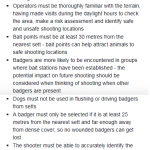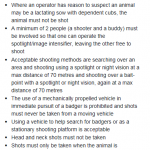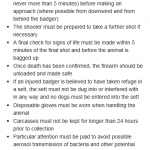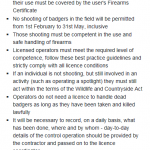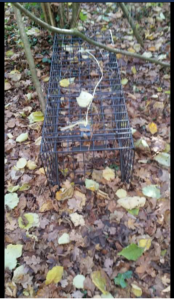Before the cull had even begun this year, a badger cub was found, alive, right next to its sett in Gloucestershire, a sett that would soon be targeted by cull contractors. The cub had a gun shot wound and was taken for treatment by a local running a ‘Wildlife Ambulance’.
Over in another part of the zone, activists were finding a huge number of bait points on a well-used footpath near to some setts!
We realised that, while we would have experience and knowledge from previous years and be able to learn from mistakes and from what went well, each year would have to be seen as a new stage and time taken at first to gauge just how things would pan out. We had learned the tactics of the shooters and learned how to combat them in the fields… but they had also learned from our tactics. It had to be remembered that they would always have the upper-hand to an extent – THEY got to choose their tactics and WE had to figure out their tactics, then figure out our tactics in response. And yet, once again, we made it difficult for them.
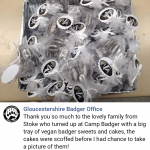
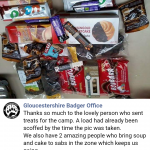 We were very lucky to be able to use the same place to camp again, as well as having a couple of other areas which owners were allowing us to use – these areas were all within or near to the cull zone and so we were easily able to protect badgers nearby without going too far. Again, we had some lovely donations keeping us going both at camp and out in the fields with ‘the soup run’ going again for another year and keeping spirits (and temperatures) up out there in the dark. They also provided opportunities for a brief catch-up in the zone to find out what was going on elsewhere and a chance for a bit of human contact!
We were very lucky to be able to use the same place to camp again, as well as having a couple of other areas which owners were allowing us to use – these areas were all within or near to the cull zone and so we were easily able to protect badgers nearby without going too far. Again, we had some lovely donations keeping us going both at camp and out in the fields with ‘the soup run’ going again for another year and keeping spirits (and temperatures) up out there in the dark. They also provided opportunities for a brief catch-up in the zone to find out what was going on elsewhere and a chance for a bit of human contact!
More information was coming in from the field and from locals and many people were now feeling confident enough to deal with situations themselves, meaning that the office collective could act as ‘normal’ anti-cull people on the ground to a large extent, responding only when absolutely necessary to back someone up or deal with a situation someone else was unable to. This didn’t mean that there were fewer phone calls or pieces of information to fit together… in fact, on some nights we were much busier than in previous years! Luckily we had put the phone on a contract that year as the amount of calls made and received and texts sent out was immense!
“There was one particular night when I was running the phonelines with my friend and she had gone off to grab us some coffee. It seemed incredibly busy once again out in the zone with calls in from lots of people who were spotting activity and needing advice and back-up and there was this lull in activity for a few minutes, so she took the opportunity to go get us drinks. Suddenly there was a call from a small group working in the north of the zone – I got phone calls from two of them at the same time, one on each of the phones I had, and I could hear them trying to radio through to another person. One of them had just been driven at by a guy called Mason Burgess [someone who had plagued and would continue to plague the cull zone with his aggression and dangerous driving] and they were trying to make sure he was ok whilst calling the police and getting away from Burgess. I had my phone out and was calling a friend, directing him and his mate to the location to back the group up as I knew the area better than he did. They arrived before the police, who responded really well themselves that night despite being in much lower numbers across the zone, and no badgers were killed in the area. Burgess would continue to have tabs kept on him by campaigners and police alike due to his behaviour… I didn’t need that coffee anymore when my mate got back with it!”
It wasn’t just Burgess who caused problems, however, but we were all gaining experience (or already dealt with such intimidation tactics out with local foxhunts) so fewer calls for back-up were being made as time went on. We would always scramble to call-outs if needed, of course, but more and more people were just calling in updates on situations that they had managed to deal with.
One really good example of people scrambling to help was when two badgers were shot in a central area of the zone. Being well-protected, shooters had become frustrated and took the shots with anti-cull people just being in the next field! As they ran to the location, the two women were threatened by the shooters and a call-out went out for anyone in the area to get to them. As soon as enough people had responded that they were on their way, we stood everyone else down so as to not pull them away from other areas which needed protection. It didn’t help that someone was calling in that shots had been taken in a different area nearby and claiming that the area was unprotected, but we were getting used to decoy calls and attempts to demoralise those in the fields.
In another incident, poachers were caught in one well-protected area drove at a vehicle belonging to a sett-sitter before shining a red ‘gun sight’ through the windscreen. They called the police, stating that campaigners had driven into them and rammed them off the road (though no collision had taken place). Police arrived to this “RTC” and a poacher shoved a campaigner as he got out to stop them tampering with his wing-mirrors and windscreen wipers (in front of the officers). Police took details from both sides, asking about the collision, which the poachers admitted had not, in fact, occurred. They were now saying that they had had to (willingly and controllably) drive off the road to get around a campaigner’s vehicle and were unhappy about it.
Despite this, police passed on campaigners’ details to the poachers (… and vice versa) due to “the RTC” (which they had just confirmed had not taken place…) “for insurance purposes”. Whilst this was going on a sab was then threatened with being shot, again right in front of the police. Officers responded by saying that they were at the scene because of “the RTC”… To be fair to them, they had been lied to in order to get them to the scene in the first place!
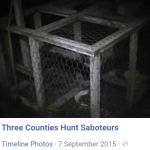
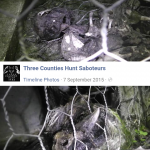 As always, it wasn’t just badger persecution that we were coming across, but evidence of other dodgy animal-related practices as well. This Larsen trap was found on Marsh Court (Eldersfield) land with skeletons of two birds within it, neither with gun-shot injuries and we’d expect birds who had had their necks broken or heads smashed to not have then been out put back into the trap. The trapdoors were still set to catch new birds / mammals but it was obvious it hadn’t been checked for some time – we suspect that the birds died from starvation / exposure / stress. Police had words with the landowners on this occasion.
As always, it wasn’t just badger persecution that we were coming across, but evidence of other dodgy animal-related practices as well. This Larsen trap was found on Marsh Court (Eldersfield) land with skeletons of two birds within it, neither with gun-shot injuries and we’d expect birds who had had their necks broken or heads smashed to not have then been out put back into the trap. The trapdoors were still set to catch new birds / mammals but it was obvious it hadn’t been checked for some time – we suspect that the birds died from starvation / exposure / stress. Police had words with the landowners on this occasion.
One autonomous group covered a particular area of the Gloucestershire cull zone where local Ledbury Hunt supporters, and other pro-cull people, were known to drive by to yell about how many badgers they had killed, etc. Cameras were put up at this sett to show the public some of the badgers that we were trying to protect.
It became apparent, like in previous years, they would take any opportunity to try and kill badgers at this sett – during the cull in 2014, tyre-tracks were spotted going in and coming out of the field in which this sett is located but monitors had only been gone less than half an hour*. Unfortunately this year the same thing happened and, while monitors were checking another area, a shot was taken and a badger killed here. A trail of blood was followed for more than 10 metres in the field, heading towards the sett, meaning that the badger was not killed outright by the first bullet.
*with 320 square kilometres to cover, it’s impossible to have sett-sitters at every sett 24/7 and most groups took on areas with clusters of setts within them to protect, meaning that they would be on foot, inland, moving around between them as best they could, or prioritising setts we had Intel on or had other reasons to believe would be more heavily targeted
Sure enough, having put the camera back up, there was one badger missing on subsequent nights.
(note: the following August, one week before the 2016 cull began, this same group caught badger baiters digging into this sett, luckily preventing any casualties – the landowner seemed more angry that the badger baiters had been caught than by their presence there…)
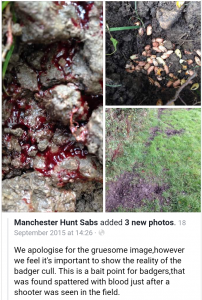 Similar images were caught around the zone, reminding everyone that we were not going to be able to save every life in this cull. Luckily we were also receiving reports from locals and shooters themselves stating that the presence of anti-cull people was putting shooters off in certain areas and that a number of cages had been found destroyed around the zone as well.
Similar images were caught around the zone, reminding everyone that we were not going to be able to save every life in this cull. Luckily we were also receiving reports from locals and shooters themselves stating that the presence of anti-cull people was putting shooters off in certain areas and that a number of cages had been found destroyed around the zone as well.
It wasn’t much of a surprise that cull guidelines were being breached all over the cull zone either. In one area a group found badger killers in a field who were trying to run away having stuffed the body of the badger into a rucksack, the body falling out as they tried to get away from the group. It’s also no surprise that, after the first year of the cull, guidelines had been made less strict, in terms of biosecurity measures such as washing down clothing and vehicles and changing boots, etc. The same went for badger cages – there was no longer a need to wash the blood off them having shot a badger…
We hoped that this would, at least, make it less likely that another badger would want to go into a cage where a fellow badger’s blood was still soaked into the earth. It said a lot about the cull company and cull contractors and their feelings on biosecurity. We’d been talking about the potential for foxhunts and badger baiters, etc. to spread bTB from infected farms to other land and, potentially, from infected badger setts to uninfected land and uninfected setts… and, of course, from infected farmland to uninfected badgers. When it became apparent that even the cull companies themselves were starting to take biosecurity less seriously, more people took note and wanted to help stop the cull.
- Cull Guidelines: Before Shooting
- Cull Guidelines: During Shooting
- Cull Guidelines: After Shooting
- Cull Guidelines: Additional Notes
The following video shows what a couple of people working in one area found. Among many other conditions, the cull guidelines state that:
1. badger bodies should be bagged up where the badger has been killed (not likely to have happened within this ditch at the side of a road)
2. badger bodies should be double-bagged (that’s TWO bags for any badger killers out there…)
3. a rope should then be tied around the neck… OF THE BAG. Not the badger…
It wasn’t just biosecurity guidelines which were being ignored and, along with investigations as to whether badgers were being shot outside of the cull zone and their bodies included in the count as well as reporting contractors believed to be putting roadkill badgers into their count (again) we were also looking at breaches of cull guidelines in other areas. The following video shows activists measuring the distance between a trail of blood from where a badger was shot to the nearest sett. Guidelines state that badgers should be at least 30 metres from a sett before they are shot at (but then the cull company doesn’t actually seem to enforce any of these guidelines, so who really cares?!) Activists filmed continuously throughout the measuring process, so we’ve edited it right down just to give an idea of the area (and also to get rid of any possible indicators of the location of the sett as the video will be public). Despite this, nothing was done about the breach.
For the first time since the cull began, the contractors reached their (minimum) target. We could beat ourselves up about it, but looking at the targets set (265 – 679) we had anticipated that they may “succeed” this year. They still killed far fewer badgers than they had done in the 6 weeks of the first year (they killed 432 this time round) and, up to this point, they still hadn’t reached the target set for the first year alone – 1650. 921 + 274 + 432 = 1627…
After the cull had ended locals carried on attending local hunt meets (hunts would be monitored and sabotaged during the cull too, but cubhunting meets are harder to find out about and, obviously, a lot of time is taken up fighting the cull). In a wood hunted by the Ledbury Hunt, where setts have been repeatedly blocked over the seasons, a badger trap was found in November by a pheasant pen. A pheasant skeleton was found inside…
“This was the first year I worked during the cull as I had a different job. I cut my hours down and did 3 d 12hr shifts a week, either finishing just before dusk or much later at night. I’d change at work, get picked up from there and head out, sometimes going home for a few hours of sleep before work again or staying with my friend, having a few hours of sleep, broken by phone calls asking for back-up, then getting to the morning meeting point, sett-checking all day, getting picked up for night time checks before going to work in the morning… looking back I’m not sure how I did it (but I know I was glad about the unlimited food available during work breaks!)”

